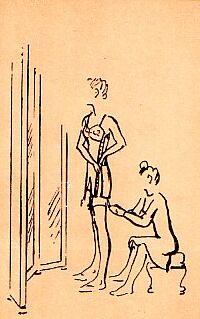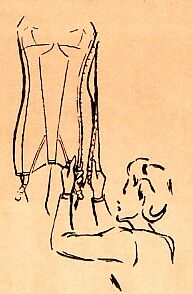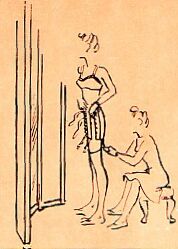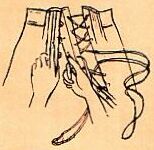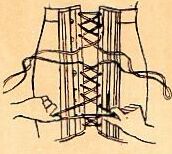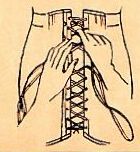Isobel is one of those
fascinating people who not only reminisces about their past experiences, but
also writes about them. Born in 1938,
Isobel grew up in the post-war years, and served for a while in a corset
shop. Very kindly, she allowed us to reproduce some of her recollections so
that we may all share her memories.
Isobel's
Recollections
Throughout
my childhood and teenage years, my parents were stationed in East Africa, and as
a consequence, in common with the children of most other European couples out
there, I was sent back to go to boarding school. In my case I ended up at school
in Scotland at age seven in 1945. Although the war was just about over,
rationing remained, and clothes were in short supply. Consequently, anything
nice you had to wear often depended on your family's pre-war circumstances and
what they had stashed away before the outbreak of hostilities and the ensuing
austerity measures. Mindful of the potential for both envy and argument that a
few well-stocked wardrobes might engender amongst a group of young girls starved
of pretty things, our school ensured a clothing equality by providing all with a
uniform list according to their seniority. This set out not only exact
quantities, but also a detailed description of each and every article of both
outer and under-clothing that we were allowed to take with us to school. To make
things easier for our often absent parents, most things on the list were
supplied through the school shop or, alternatively, from a few local suppliers.
This, of course, further ensured a rather drab and dour uniformity, which I
believe, was probably their goal. Being a Scottish school which believed in the
national virtue of thrift, and given that both money and precious coupons were
in short supply, it was customary for all still serviceable clothing to be
handed down from the older girls to younger ones, a fairly easy task to
accomplish as we were kept in school uniform throughout the week and weekends,
with the one personal dress we were allowed being set aside for special occasions and
hence, in practice, rarely worn.
I
started wearing a girdle, at around age 14, as a compulsory part of all the
senior girls' school uniform. Prior to that, our black lisle uniform stockings,
commonly worn by schoolgirls before cheap nylons became readily available, were
kept up by means of suspenders attached to a front-buttoning liberty bodice, and
I remember well how those hated garments were happily discarded in favour of the
far less comfortable girdles and bras with which we were then issued. The school
Matron, a formidable Scotswoman in her late 50's, whom even the school staff
treated with a mixture of respect and fear, in common with many women of that
generation who had been brought up wearing corsets, believed that for a girl to
both acquire and retain a good figure and to learn to comport herself in a
ladylike manner, it was essential that she be put into good, strong foundations
as soon as she started to develop curves. Matron therefore treated the matter of
choosing and having her girls fitted with appropriate garments as her personal
mission, if not her sacred duty, and those few mothers who foolishly suggested
that this might be left to them were dealt with in Matron’s inimitable
fashion whereupon they never interfered again.
Unlike
other elements of our school uniform, foundation garments were not supplied
through the school shop. It was Matron's practice to arrange for a fitter from a
corset shop in Glasgow, with whom the school had been doing business since the
early 1900's, to visit biannually at the beginning of both the autumn and summer
term. During the day or two she spent at the school, all the older girls were seen,
fitted and wherever possible supplied with both bras and girdles from an
extensive range of samples she brought with her in a small van. For those that
needed alterations to a selected garment, or where she didn't have the size or
style which had been chosen, these would be dispatched by post a few days after
her return to Glasgow. To simplify and speed up the fitting process, choice was
taken out of the hands of the wearer, all decisions being agreed between the
fitter and Matron. Wherever possible, a garment from a previously chosen
standard range, based on support provided, durability and ease of laundering,
was picked; the only variables then being the size, width and length needed to
suit the particular girl’s statistics. Throughout most of my senior school
years for me this meant a short girdle and bra in a white cotton cloth, devoid
of decoration, with strong elastic side panels and some light boning. Other
girls, blighted with a heavier figure than I, faired less well, finding
themselves in the deep, heavily boned models within the same range.
This
all seems like an age ago now, and of course it was. In a different world with
different values, I doubt whether any youngster today would put up with what we
put up with then, although we really didn't complain much. Of course, back then
women didn't expect to be at ease in their clothes, and we all wore girdles
because one just did, society expected it of us and we wanted to look good. When
I look around at some young people today, sometimes I think we did look better,
but maybe that's just a function of my age. (I
don’t think so, Isobel. Posture and grace are ageless, and many people today
fail to understand that. So often I’ve observed the legions of today’s
‘nouveau riche’ in their so-called designer clothes, totally failing to hide
their own lack of grace. I said to my husband “you can’t make a silk purse
out of a sow’s ear.” He nodded “You shouldn’t try to put a sow’s ear
in a silk purse either” he replied! Ivy Leaf).
Upon
leaving school in 1955, having no family home in Britain, I moved with a school
friend to a market town in the northeast of England. Here we shared a house
owned by her mother, a widow by name of Mrs. Rogers, who happened to be the
proprietor of the largest specialist corsetry and lingerie shop in the town. It
was soon suggested, that I could earn my keep by helping her out at the shop, to
which, having nothing better to do, I agreed, intending to fill in for a month
or two, and ending up staying for over six years until I married in 1963.
Mrs.
Rogers, a women in her mid 50's, was an experienced corsetiere but very much of
the old school, having worked in the industry since leaving school, at age 14,
firstly at the Symington Corset Company in Leicestershire, and then later at a
large Manchester corset maker and retailer where she was trained as a
professional fitter. She employed three others to work alongside her in her
business, two shop girls, Sandra, her daughter, myself, and Doris the
seamstress, who worked in the backroom mending, altering and making up the
occasional custom garment for customers.
Even
by the standards of a North Yorkshire town in the 1950's the local residents,
though quite prosperous, were by nature very conservative. Women, both old and
young alike, tended to choose all undergarments first and foremost on the basis
of what they were accustomed to wearing, and after that on fit, function,
serviceability, and price, with attractiveness being of little or no importance
to most. When it came to their foundation garments, many treated innovation, or
indeed any change, with a deep sense of suspicion and there were ladies, and not
only the older or larger ones, who, despite an ever widening choice of modern
foundations based on elasticated yarns, insisted on sticking with the sort of
corsetry that one might have imagined their mothers wearing forty years earlier.
To
illustrate this, throughout my first few years working with Mrs. Rogers, for
every three girdles or corselettes we sold, we would also sell at least one
rigid-style lace up corset, not unusually fitted with a front busk and underbelt
for further control. At first, surprised by a request for such a garment from a
relatively young and not overweight customer, I would unwisely offer her a far
more comfortable and modern alternative. However, after being told repeatedly
that I was far too young and inexperienced to understand their needs, and then
later admonished by Mrs. Rogers for trying to interfere with a customer's most
reasonable, and incidentally often expensive, choice, I soon learnt to serve and
comment only if asked. Sadly, the general unwillingness of our customers to try
things new or be adventurous was reflected in the stock we held for sale, and
consequently the many beautiful confections coming out of the French lingerie
houses remained little more than pictures in our trade catalogues.
Alison
has given us an account of the Spen-all corselette that she was required to wear
when serving customers. Much like Alison's boss, Mrs. Rogers similarly dictated
what foundation wear I would be obliged to wear whilst working in front of shop,
believing that a salesgirl with a compact, moulded figure, upright posture and
gracefully restrained movements would reflect favourably on her skills as a
fitter as well as generally upon the benefits of good corsetry. Unfortunately
for me, Mrs. Rogers chose my work wear foundations for visual effect with an
emphasis on control and containment, and with little thought to my comfort.
Being naturally petite, slim and small-breasted, I had always worn a short
elastic-sided girdle and regular length bra. It was therefore with some dismay
that I found myself being fitted from a selection of well-boned corselettes, and
similarly constructed high-waisted, side-fastening girdles and padded, long-line
brassieres, all of which left me compressed from bust to mid thigh beneath
panels of powernet and stiffened, unyielding brocade or satin. At first, not
even the unarguably excellent figure and wonderfully full bust I instantly
seemed to possess compensated for the tightness and stiffness, which at best I
found irksome and at worst downright painful especially after a long, busy, and
hot day. For the first few months, I would rush home as soon as the shop closed
to get out of my wretched armour cladding. However, as so many women discover,
there is something addictive about a really firm girdle, and after a while I
found myself missing the tightness, support and control at weekends, when my
foundations would consist of little more than an elastic roll-on and short bra.
Consequently, when my casual foundations needed replacement, I started to
substitute them with things of ever increasing firmness and length, until my
lingerie drawer boasted little at all in the way of light control garments.
|
|
As
the trained professional, Mrs. Rogers took charge of all customer fittings,
though as many of our clients already knew what they wanted, her role was often
reduced to merely checking measurements and congratulating the customer on her
most excellent choice. Of course, as most middle age or older women tended to
squeeze themselves into the heavier, more complex and expensive garments, she
had little financial incentive in steering a customer towards a lighter and
cheaper substitute. At first, I mostly served behind the counter, selling
lingerie, underwear, stockings and some foundations garments where no fitting
was wanted. However, as I gained greater experience, I was increasingly asked to
assist in the fitting room, especially with our younger clientele, who it was
felt might better accept the opinion of someone closer to their own age,
although in truth my instructions were to concur fully with everything Mrs.
Rogers said. In particular, I often found myself helping when customers brought
their daughters in for that, potentially troublesome, first fitting. Alison's
recollection of an occasion when she was asked to make an especially firm
control corselette for some young hoyden to curb her excessive boisterousness,
reminded me of more than a few difficult first fittings.
|
|
By the 1950's, tight-lacing was thankfully a practice long gone. Nevertheless,
the Victorian principle "if you want your daughter to grow up demure and
obedient lace her tight,” still influenced some mothers. These ladies
genuinely believed that the physical moderation imposed by firm foundations,
helped transform a young girl into a young lady, and as a consequence, more than
a few ended up in foundations not dissimilar to those Mrs. Rogers had chosen for
me. However, I remember a dozen infamous occasions when some grandmother or
elderly maiden aunt was left to make the choice, when I’d end up helping to
fit a tearful teenager into a lace up corset at the insistence of her elders,
mindful of her own youthful experiences half a century earlier. Not
surprisingly, I was often faced with a fractious teenager most unhappy with what
she was expected to wear, and it was left to me to persuade her that the
offending garments were precisely what she needed to improve, but above all,
preserve her figure, and though they might seem uncomfortable this would pass as
she grew accustomed to them. Usually a little coaxing and flattery, combined
with the girl's natural vanity, and her fear of incurring the displeasure of her
elders was sufficient to turn her voiced objections, if not to enthusiasm, at
least to a sullen resignation.
It
should be remembered that most women in the 1950's wore girdles and bras which
would be considered very firm by today's standards, as a result of which, from
an early age, we grew so accustomed to the many inconveniences and discomforts
imposed upon us by our foundations, that we were often unaware of them. Of
course, a long and firm open girdle restricts one's stride, makes running nigh
on impossible, and sitting less than comfortable, however, those tight skirts
which went in and out of fashion did very much the same. What I do recollect,
however, was the way in which the vivid red marks left imprinted upon my body by
the boning of my work foundations remained there for hours after the offending
garments had been removed.
Much
has been said about the discomforts and even health risks associated with girdle
wearing back in the 50's and 60's, some of which may be true though I believe
greatly exaggerated. The anti-girdle lobby has even politicised the garment as
symbolic of the repression of women. It is my belief that everything has to be
taken in the context of the time. I remember only too well that even in the
1950's we felt liberated when we compared themselves to our mothers. Even in the
small matter of girdles, although I accept we had to wear them, they were
advertised as ‘light, flexible and cool', and they often were when compared
with the previous generation of foundation garments. What brought this home to
me was one particularly hot, busy day in the shop. I made some slight complaint
to my boss about my girdle, that was by late afternoon ‘killing me’. Far
from being sympathetic she recounted that aged 17, working as an apprentice
corsetiere, she would assist at the corsetry counter of a small department
store. Whether serving customers or working behind the scenes, she was required
to look ‘smart and trim’, which meant not only being corseted but tightly
so. This rule applied not only to those working in the corsetry department, but
to all the shop girls employed in the store. Furthermore, supervisors could and
did send girls home if they were thought to be insufficiently ‘trim’ with
the threat of instant dismissal for a repeated offence. Harsh you may think, but
according to my boss they too thought themselves fortunate and liberated by
their modern ‘scientifically designed’ corsets which, which when compared
with what their mothers had had to wear, were both ‘healthy’ and capable of
being laced tightly with ‘absolute comfort’!
We
did have and serve a number of gentlemen customers too, some of whom had been
regular clients for many years. Though my
boss never permitted me to conduct a girdle or corset fitting for an adult male,
I was allowed to serve them across the counter for repeat orders or sell them
other items which didn't require a fitting. Though, at
first, as a rather naive and sheltered 18 year old, I found it rather
embarrassing to be selling foundations and other articles of women's underwear
and lingerie to men whom plainly intended to wear what they were buying, I soon
came to appreciated these customers as being both less demanding and far more
courteous than many of the ladies with whom we conducted business.
As
we entered the 1960’s, youngsters started to develop their own voice and were
no longer willing to be forced into things uncomfortable at the behest of
anyone, least of all their mothers. Although the ritual of mothers bringing
their daughters to Mrs. Rogers for their first fitting continued right up until
the time I left the business, these girls increasingly knew what they wanted and
what's more, unlike their predecessors, usually got their way, despite the fact
that this rarely coincided with Mrs. Rogers' opinion of what they needed. It was
then that my employer started to loose her rearguard battle, waged for years,
against the panty-girdle, which she had always deplored. Right up until the end
of the 1950's, she had managed to get away with carrying no more than a handful
of panty-girdles in stock, kept for those who preferred to wear them, rather
than a standard girdle, under slacks or those who, usually engaged in some
active sport. By the 1960's, even Mrs. Rogers could no longer hold
back the tide of demand that swept in from all her younger clients, and the
dreaded panty-girdle was there to stay as it started to sell in ever increasing
numbers.
After
I left the shop, the tide of change flowed ever faster, and a defeated Mrs.
Rogers closed the shop in 1968 and retired to the south coast.
